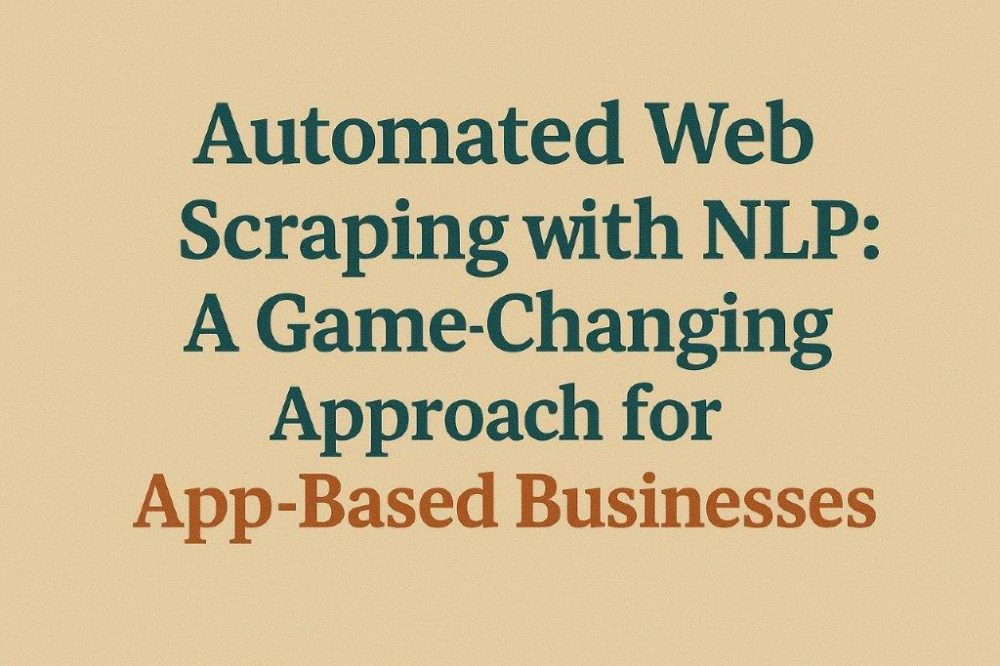In the current era of competitive digital landscape, staying ahead requires continuous gathering and leveraging of data. This is specifically crucial for app-based businesses where success is mostly based on real-time insights into user behavior, competitor strategies, as well as market trends. Traditional web scraping offers raw data, but its true potential can only be utilized in combination with Natural Language Processing (NLP). This combination helps in creating an automated, highly intelligent data acquisition system, which in turn presents an advanced approach for app companies that are seeking a decisive competitive edge.
The Limitations of Traditional Scraping
Standard web scraping mainly involves fetching and parsing HTML for extracting structured data like product names, prices, ratings, and others from websites. Even though traditional scraping may be effective for simple, steady data sources, it generally faces issues with unstructured data that are present on the web, mostly in content-rich environments such as social media, forums, as well as customer review platforms. Key limitations related to traditional scraping are:
- Information Overload
- Issues Related to Scalability
- Contextual Blindness (Traditional scrapers are not capable of understanding meaning or sentiment behind text)
NLP: The Data Intelligence Layer
NLP is an important technique that is capable of converting raw, inert text data into intelligent and structured information. Applying NLP techniques can help app-based businesses obtain knowledge that was not accessible previously or may be too costly for processing manually.
1. Advanced Sentiment and Emotion Analysis
The key application for app businesses is collecting actionable insights from customer feedback, which may include app store reviews, support tickets, as well as external reviews on social media or blogs.
- Active Issue Detection: Automated scraping in combination with NLP, can provide an early warning solution. An increase in negative sentiment related to a specific feature, when detected in real-time across numerous platforms, can assist in alerting development teams for a critical bug before it results in mass uninstalls.
- Beyond Polarity: NLP does not just categorize feedback as positive or negative, instead it is also capable of detecting specific emotions (delight, frustration, confusion) and intensities.
2. Competitor Feature Benchmarking and Differentiation
The competitive intelligence is crucial for determining the product roadmap as well as scraping competitors data and app descriptions generates basic data, but NLP reveals the narrative and focus.
- Feature Topic Modeling: NLP techniques such as topic modeling can analyze thousands of competitor reviews and marketing materials to automatically identify the most reviewed features. For determining the productivity app, it reveal that competitors are heavily promoting cross-device sync while users are consistently complaining about the lack of a clear gap for differentiation.
- Pricing and Promotion Strategy: Scraping promotional announcements and terms of service allows NLP to extract and categorize specific pricing tiers, discount structures, and conditions, in turn providing a view of competitor financial strategies.
3. Hyper-Personalized Content Curation
Many modern apps, especially e-commerce, and content delivery, majorly rely on external information. Additionally, automated scraping with NLP ensures the content shown to users is relevant as well as contextually rich.
- Entity Recognition: The technique identifies and categorizes key information such as people, organizations, locations, dates within scraped text. For example, NLP helps to identify all companies and executives mentioned, a finance app can scrape market news as well as provide automatic tag to the news for informing a user’s personalized stock portfolio feed.
- Content Summarization: For apps that curate large volumes of external articles or research papers, NLP’s text summarization capabilities can automatically generate short summaries, allowing users to quickly consume vast amounts of information directly within the app’s interface.
The Technical Advantage: Automation and Efficiency
The collaboration between automated scraping and NLP establishes a pipeline that minimizes human intervention and expands data throughput. The scraping pipeline gathers the raw text while the NLP pipeline cleans, improves, and organizes the text with labels as well as categories. As the data is clean and pre-labeled, a user can feed it directly into AI based systems and analytics tools. This in turn dramatically decreases costs and gives actionable information faster than before.
Conclusion
The time of simple as well as rule-based extraction of data and content from websites is fading. Most successful app businesses in today’s time ought to instantly make sense and understand the disorganized information on the web which is essential for their survival. The businesses by using automated web scraping and NLP gain a sophisticated tool to recognize the behavior of the user and predict market changes as well as help in building products that users are willing to buy. This intelligent data system lets them create a clear plan for growth and step beyond simple data gathering to proactively make the finest decisions. This approach not only improves efficiency but also secures the company’s future.
